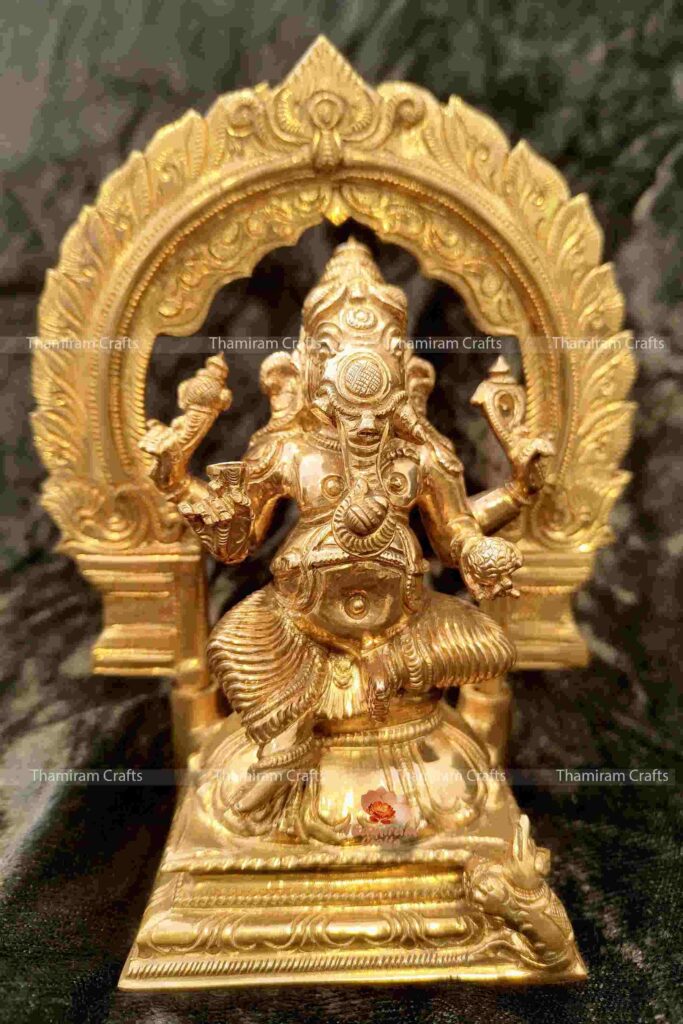A Bronze Ganesha statue is a revered depiction of Lord Ganesha, the elephant-headed deity known for his wisdom, prosperity, and role as the remover of obstacles. These statues are rich in symbolic meaning, with each feature conveying profound philosophical insights and spiritual significance. The key attributes of a Bronze Ganesha statue—modaka, axe, noose, and broken tusk—are essential elements that reflect the multifaceted nature of the deity and his deep connection to Hindu traditions.

1. Modaka (Sweet):
The modaka, a sweet often seen in Ganesha’s hand, is symbolic of spiritual fulfillment and prosperity. In Hindu mythology, Ganesha’s love for modaka represents the joy of devotion and the rewards of self-discipline and wisdom. This sweet embodies the balance between material prosperity and spiritual well-being. In Ganesha’s iconography, the modaka signifies that true happiness comes from both intellectual growth and emotional contentment, making it a central theme in Ganesha’s representation.
History of Modaka (sweet)
The modaka is a significant symbol in Lord Ganesha’s iconography, representing spiritual wisdom, material abundance, and inner bliss. The sweet, often depicted in Ganesha’s hand, holds both mythological and philosophical importance in Hindu traditions.
Mythological Significance:
- Favorite Sweet of Ganesha: According to Hindu mythology, Ganesha’s love for modaka is well known. It is said that Ganesha would always crave this sweet, which is typically made of rice flour, jaggery, and coconut. This devotion to modaka represents the enjoyment of simple pleasures and the satisfaction that comes with spiritual wisdom.
- Symbol of Prosperity and Fulfillment: The modaka is considered a symbol of the rewards that come from spiritual pursuit and discipline. In various stories, Ganesha is offered modakas by his devotees as a sign of respect and devotion. The sweet is often depicted as a reward for those who follow the righteous path and practice devotion and wisdom.
- Spiritual and Material Balance: The modaka, in Ganesha’s hand, also signifies the balance between the material and spiritual worlds. It suggests that one can achieve both material prosperity and spiritual fulfillment through devotion, wisdom, and discipline. It teaches that true happiness is a combination of worldly pleasures and spiritual growth.
Philosophical Symbolism:
The modaka is believed to represent the ultimate reward of inner peace and wisdom. By breaking the modaka into its components—coconut (knowledge), jaggery (sweetness of life), and rice (nourishment)—the symbolism becomes clear: to attain true prosperity, one must combine knowledge, sweetness of heart, and nourishment for the soul. In this way, Ganesha’s modaka symbolizes the harmony between intellectual, emotional, and physical well-being.
Depiction in Iconography:
In bronze Ganesha statue, the modaka is often held in one of his hands, symbolizing the abundance of blessings. Whether depicted in the traditional sitting pose or in dynamic postures, the modaka remains a constant feature in the iconography of Ganesha, representing his ability to bestow happiness, wisdom, and prosperity on his devotees.
In summary, the modaka is a timeless symbol of Ganesha’s grace and the rewards that come from following the path of righteousness, wisdom, and devotion. Its presence in Ganesha’s iconography reflects the belief that both spiritual and material fulfillment are attainable through discipline and devotion.
2. Axe (Parashu):
The axe in a Bronze Ganesha statue symbolizes the destruction of ignorance and the cutting off of attachments to worldly distractions. It represents Ganesha’s power to remove obstacles from the path of his devotees and his ability to guide individuals toward spiritual enlightenment. Often depicted in Ganesha’s hand, the axe highlights his role as a protector who helps devotees overcome challenges, conquer negative tendencies, and achieve a balanced life.
History of Axe (parashu)
The axe (Parashu) is one of the key attributes often depicted in Lord Ganesha’s hands, and its history and symbolism are deeply rooted in Hindu mythology. While the axe is not associated with a single definitive event in Ganesha’s stories, its presence conveys significant philosophical meanings and divine powers.
Historical and Mythological Significance:
- Symbol of Detachment: The axe represents Ganesha’s power to cut through ignorance, illusions (maya), and material attachments that bind individuals to the cycle of birth and death. It encourages devotees to detach from worldly distractions and focus on spiritual growth.
- Inheritance from Shiva: The axe is often seen as a weapon gifted by Ganesha’s father, Lord Shiva. In Hindu mythology, Shiva is frequently depicted with an axe, symbolizing his role as a destroyer of evil and illusions. Ganesha, as Shiva’s son, inherits this tool, which reinforces his role as a remover of obstacles.
- Protector and Destroyer: The axe reflects Ganesha’s dual nature—compassionate protector and fierce destroyer of negativity. It is believed he uses it to cut down obstacles on the path of his devotees while also safeguarding them from harm.
Depiction in Iconography:
The axe appears in Ganesha’s statues and paintings, particularly in Chola bronzes and other South Indian artistic traditions. It is typically held in one of his hands, often paired with other symbolic items like the noose, modaka, and broken tusk.
The inclusion of the axe in Ganesha’s iconography signifies his role as a guide who empowers individuals to overcome challenges, conquer ignorance, and achieve enlightenment through discipline and wisdom.
3. Noose (Pasha):
The noose in Ganesha’s hand is a symbol of restraint and the power to pull individuals closer to their spiritual goals. It represents Ganesha’s ability to bind ignorance and negativity, helping devotees break free from the cycle of material attachment. The noose reflects Ganesha’s dual nature, where it can both entangle and liberate, guiding followers to enlightenment while helping them detach from worldly distractions.
History of Noose (pasha)
The noose (Pasha) is a significant symbolic attribute often depicted in Lord Ganesha’s iconography and has its roots in Hindu mythology. While it is not tied to a specific historical event like the broken tusk, its presence in Ganesha’s hands carries profound philosophical and spiritual meanings:
- Symbol of Control: The noose represents restraint and control over desires, ego, and material attachments. It signifies Ganesha’s ability to guide devotees by pulling them closer to the path of righteousness and self-realization.
- Binding Obstacles: In Hindu tradition, the noose is seen as a tool used by Ganesha to capture and remove obstacles that hinder spiritual and material progress. It also symbolizes his power to bind ignorance and negativity.
- Dual Nature: The noose’s dual role reflects the idea of entanglement and liberation. While it can bind individuals to worldly illusions, under Ganesha’s guidance, it becomes a means to free them from these ties.
The noose is a recurring element in ancient Indian art and sculpture, featured prominently in depictions of Ganesha across regions and dynasties, including Chola bronzes and Gupta-era carvings. Its presence highlights Ganesha’s role as both a protector and a guide, helping devotees overcome life’s challenges and achieve spiritual growth.
4. Broken Tusk:
The broken tusk of Lord Ganesha carries significant symbolic meaning in Hindu mythology. It represents sacrifice, wisdom, and perseverance. According to popular legends, Ganesha broke his tusk to write the Mahabharata, showing his commitment to duty. The tusk also signifies overcoming imperfections and challenges, teaching devotees that wisdom and perseverance often come through self-sacrifice. It is a powerful reminder of the importance of resilience in spiritual growth.
History Of Broken Tusk
The story of Ganesha’s broken tusk is rooted in Hindu mythology, with several variations across different texts, each carrying profound symbolism. Here are two prominent legends associated with the broken tusk:
- Writing the Mahabharata: According to the Mahabharata, sage Vyasa sought Ganesha’s help to transcribe the epic. Ganesha agreed on the condition that Vyasa would dictate continuously without pause. During the process, Ganesha’s pen broke. To keep his promise, Ganesha broke off his tusk and used it as a writing instrument, demonstrating his dedication, intellect, and adaptability.
- Battle with Parashurama: Another legend from the Puranas narrates that Parashurama, a devotee of Shiva, visited Kailasa to meet the deity. Ganesha, guarding his father’s abode, stopped him, leading to a confrontation. In his anger, Parashurama hurled his axe at Ganesha. Out of respect for the weapon, which was a gift from Shiva, Ganesha did not defend himself and allowed the axe to strike, breaking his tusk. This story signifies humility and respect for divine authority.
The broken tusk symbolizes sacrifice, adaptability, and wisdom, teaching that overcoming challenges often requires personal loss for the greater good. It is a hallmark feature of Ganesha’s iconography, reflecting his role as the remover of obstacles and a guide to enlightenment.
Conclusion:
A Bronze Ganesha statue is more than just a work of art—it is a powerful symbol of Ganesha’s divine attributes and the values he represents. Whether displayed in homes, temples, or offices, these statues serve as a reminder of the spiritual journey toward wisdom, prosperity, and the removal of obstacles. By understanding the symbolic meanings of the modaka, axe, noose, and broken tusk, one can truly appreciate the deep philosophical essence that these key elements bring to the iconography of Lord Ganesha.


Leave a Reply